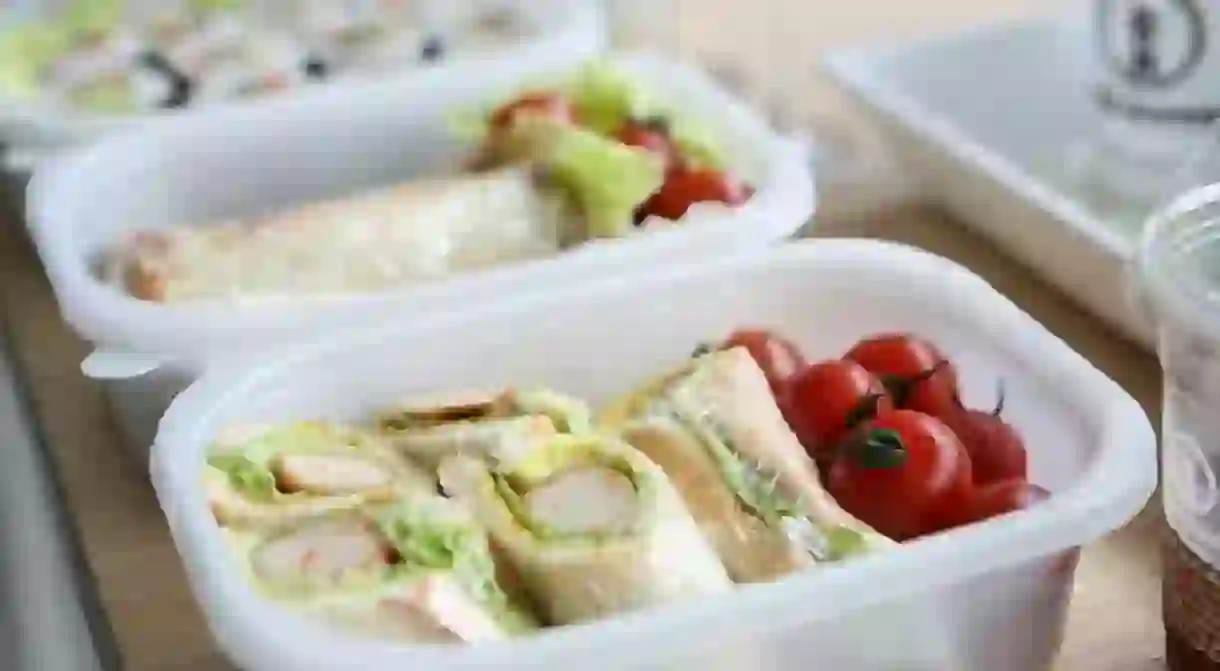The Things You Need To Know To Master The Art Of The Bento

When most people think of bento, they think of an ordinary packed lunch. However, bento are not necessarily homemade, and they can be eaten for any meal, not just lunch. The difference between an ordinary packed lunch and a bento is the one-box presentation, and the addition of ingredients that carry and keep well without the need to heat them up or keep them cool. The convenience of a store-bought bento is certainly hard to contest, but nothing beats a bento made and packed at home with love. A lot goes into these seemingly simple meals. Here are the things you need to know to master the art of the bento.
Selection
A typical bento contains a variety of foods. Rice often makes up the base or bulk of the meal, while vegetables and protein in the form of meat or eggs round it out. Substitutions like bread or pasta instead of rice are easy to make. More traditionally, pickled vegetables, tamagoyaki (scrambled fried egg, folded and often cut into rectangle shapes) and broiled fish are popular. When choosing food for your bento, pick items that taste good at room temperature and that are easy to carry.

Portions
Most bento are meant to be a single complete meal for one person. Serving sizes and food selection are customized for the individual, and they are usually different for women, men and children according to everyone’s unique nutritional needs. For example, a man with a physical job in construction might have a double serving of rice, while a women who works at a desk might skip the rice altogether. Find out your nutritional needs and plan your bento accordingly.
Box
Bento have been around for centuries. The earliest bento weren’t carried in boxes at all, but woven bags that could hang from a belt or pack. Later, wooden lacquer or square bamboo boxes and even tin came into fashion. Today, the most popular material for a homemade bento is good old-fashioned sturdy plastic. The rectangular shape is easy to pack and carry and the design options are endless. Boxes that come apart in stackable compartments are popular as they make packing lunches easier. Choose a bento box that’s just the right size for your meals.

Tools
Tools to make your bento special are optional, rather than necessary. Once you have a sufficiently large box to pack it in and a set of utensils, you’re ready to make bento. Things like onigiri (rice ball) presses to make animal forms and hole punches to make heart shapes from your dried nori (seaweed) sheet are a nice touch, but most people won’t have time for these things everyday. Instead, focus on learning quick bento recipes like tamagoyaki and invest in a good quality rice cooker.
Packing
These days, packing a bento is easy. If your bento box doesn’t come with prearranged dividers, you can use everyday items and even the food itself to get organized. For example, an ordinary silicone muffin cup makes a great reusable cup to keep pickled foods from prematurely flavoring the rest of the box contents. Use a strip of lettuce to protect rice from absorbing the sauce of that tamagoyaki. The goal of bento is to make a visually-appealing meal that you can’t wait to open at lunch.

Sport
In Japan, many people take their homemade bento seriously. Kyaraben, a transliteration of ‘character bento’, are boxed meals designed to look like characters from cartoons, anime, comic books or video games. Alternatively, oekakiben are bento made to looks like real-life people, objects and animals, with as much or as little detail as the bento artist desires. Contests to judge the best bento design are not uncommon, and are a fun way to get ideas for your own bento.
Furoshiki
A furoshiki is a cloth that wraps around the bento box. It’s not only decorative but functional. The furoshiki provides a handle and acts as a placemat or tablecloth once it gets to the destination. Making sure that your furoshiki coordinates or compliments your bento box and utensils nicely will add even more appeal to your bento.

Time
Making a bento often takes more time and effort than an ordinary packed lunch. While it’s certainly possible, and even encouraged, to use leftovers from dinner in your bento, this isn’t always possible, items that don’t transport well, like soup, or that must be refrigerated to stay fresh, like yogurt, are not great additions to your bento. Therefore, it’s important to plan your bento accordingly to ensure you won’t end up with a spoiled, soggy mess.
Occasions
Bento are not just for work or school lunches. They are also popular for outings like picnics, hikes and hanami (flower-viewing) parties. Special ekiben are sold at train stations for those going on long trips. Those wanting to get into bento but who might not have the time can practice their bento-making skills on weekends for trips and excursions outside the home. As an added bonus, by bringing a bento from home you’ll save money on restaurant and takeaway bento, too.














